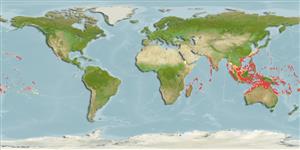Environment: milieu / climate zone / depth range / distribution range
Ökologie
seewasser; brackwasser riff-verbunden; tiefenbereich 1 - 80 m (Ref. 90102). Tropical; 35°N - 25°S
Pacific Ocean: northwest Australia, Moluccas, and Philippines to the Marquesan and Society islands, north to Ryukyu Islands, south to Rowley Shoals, Western Australia, and Tonga; Mariana and Caroline Islands in Micronesia.
Size / Gewicht / Alter
Maturity: Lm ? range ? - ? cm
Max length : 13.6 cm TL Männchen/unbestimmt; (Ref. 90102); common length : 10.4 cm SL Männchen/unbestimmt; (Ref. 37816)
Kurzbeschreibung
Morphologie | Morphometrie
Rückenflossenstacheln (insgesamt): 12; Rückenflossenweichstrahlen (insgesamt): 9; Afterflossenstacheln 3; Afterflossenweichstrahlen: 5. Submarginal black band on inner pectoral fin surface complete; eyes relatively large; snout relatively short; hump on back less obvious as in S. diabolus; SL to 10.4 cm. No black spot nearly as large as eye on inner surface of pectoral fins. A narrow triangular black mark inside mouth at front of upper jaw behind teeth. Ascending process of premaxilla broad, its maximum width 1.4-1.8 in orbit diameter. No series papillae or nodules across interorbital space between supraocular spines. Nasal spine single (Ref 42181).
A rare inhabitant of mixed sand and rubble areas of reef flats and shallow lagoons. Feeds on fishes (Ref. 89972). Usually buries itself in the substrate when in sand or sits amongst rubble where it has good camouflage (Ref. 48635). Anterolateral glandular grooves with venom gland (Ref. 57406). Solitary or in pairs (Ref 90102).
Life cycle and mating behavior
Geschlechtsreife | Fortpflanzung | Ablaichen | Eier | Fecundity | Larven
Myers, R.F., 1991. Micronesian reef fishes. Second Ed. Coral Graphics, Barrigada, Guam. 298 p. (Ref. 1602)
IUCN Rote Liste Status (Ref. 130435)
Nutzung durch Menschen
Mehr Information
NamenSynonymeMetabolismusRäuberÖkotoxikologieFortpflanzungGeschlechtsreifeAblaichenSpawning aggregationFecundityEierEientwicklung
ReferenzenAquakulturAquakultur ProfilZuchtlinienGenetikElectrophoresesVererbbarkeitKrankheitenVerarbeitungNutrientsMass conversion
PartnerBilderStamps, Coins Misc.LauteCiguateraGeschwindigkeitSchwimmstilKiemenoberflächeOtolithsGehirngrößeSehfähigkeit
Tools
Zusatzinformationen
Download XML
Internet Quellen
Estimates based on models
Preferred temperature (Ref.
123201): 25 - 28.9, mean 27.7 °C (based on 672 cells).
Phylogenetic diversity index (Ref.
82804): PD
50 = 0.5000 [Uniqueness, from 0.5 = low to 2.0 = high].
Bayesian length-weight: a=0.01259 (0.00606 - 0.02615), b=3.03 (2.86 - 3.20), in cm total length, based on LWR estimates for this (Sub)family-body shape (Ref.
93245).
Trophic level (Ref.
69278): 3.9 ±0.7 se; based on size and trophs of closest relatives
Widerstandsfähigkeit (Ref.
120179): hoch, Verdopplung der Population dauert weniger als 15 Monate. (Preliminary K or Fecundity.).
Fishing Vulnerability (Ref.
59153): Low vulnerability (10 of 100).
Nutrients (Ref.
124155): Calcium = 86.4 [42.3, 185.0] mg/100g; Iron = 0.783 [0.399, 1.637] mg/100g; Protein = 18.2 [16.1, 20.2] %; Omega3 = 0.272 [0.111, 0.722] g/100g; Selenium = 25.5 [12.1, 60.9] μg/100g; VitaminA = 249 [79, 763] μg/100g; Zinc = 1.67 [1.10, 2.46] mg/100g (wet weight);
